Birds in Greater Poland are a diverse and fascinating group of animals. The region is located in the western part of Poland and is home to various bird species, including raptors, waders, waterfowl, passerines, and many more.
Over one hundred and sixty species of birds have been recorded in Greater Poland, making it an excellent place for bird watchers and nature lovers. The area is home to several extensive wetlands, woodlands, and grasslands, all providing habitats for different species of birds.
The region also offers excellent opportunities for bird migration, with some species traveling from as far away as Scandinavia and North Africa. With so much to offer, Greater Poland is a great place to explore the wonderful world of birds.
24 Birds to Watch in Greater Poland
Greater Poland is a region in western Poland that offers a variety of habitats and bird species for birdwatchers. Whether you are looking for raptors, waterfowl, waders, woodpeckers, or passerines, you will find something to enjoy in this area.
Here are 24 birds that you should not miss when visiting Greater Poland.
1. White-tailed Eagle
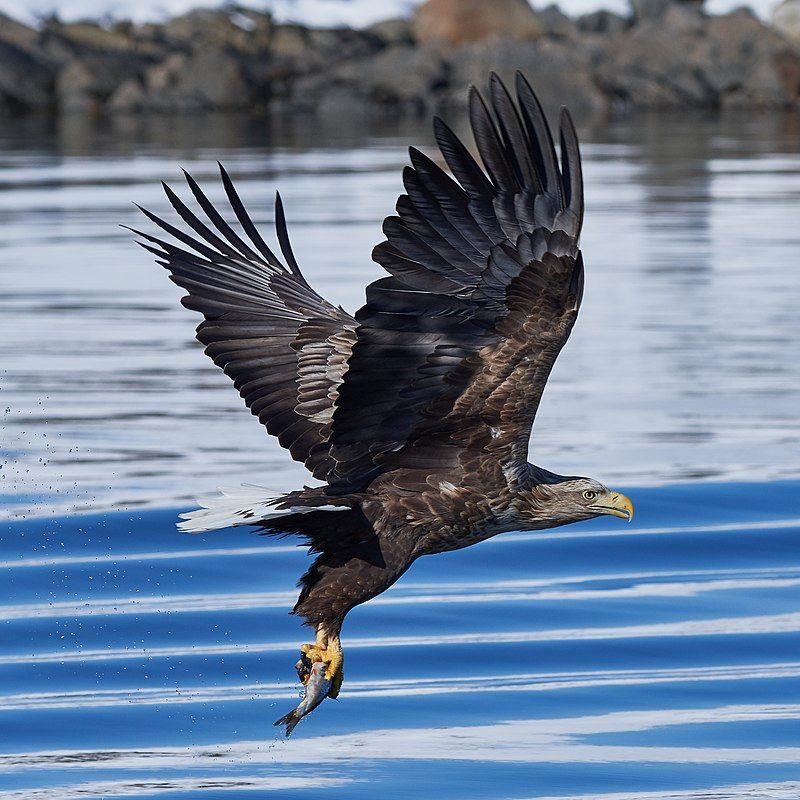
The white-tailed eagle, sometimes called the “sea eagle,” ” is a large bird of prey across temperate Eurasia. It is a member of the family Accipitridae, which includes other diurnal raptors, such as hawks, kites, and harriers.
All these birds belong to the same scientific family, meaning they share a common evolutionary ancestor. The white-tailed eagle is one of the most giant birds, with a wingspan of up to 2.5m.
They are known for their sharp eyesight and strong talons, which they use to capture their prey. They typically feed on fish, small mammals, and carrion. They are both graceful and powerful in flight and are often seen soaring high above the ground.
White-tailed eagles symbolize strength and power and have been used as a national symbol in several countries.
| Kingdom | Animalia |
| Phylum | Chordata |
| Class | Aves |
| Order | Accipitriformes |
| Family | Accipitridae |
| Genus | Haliaeetus |
| Species | H. albicilla |
2. Mallard
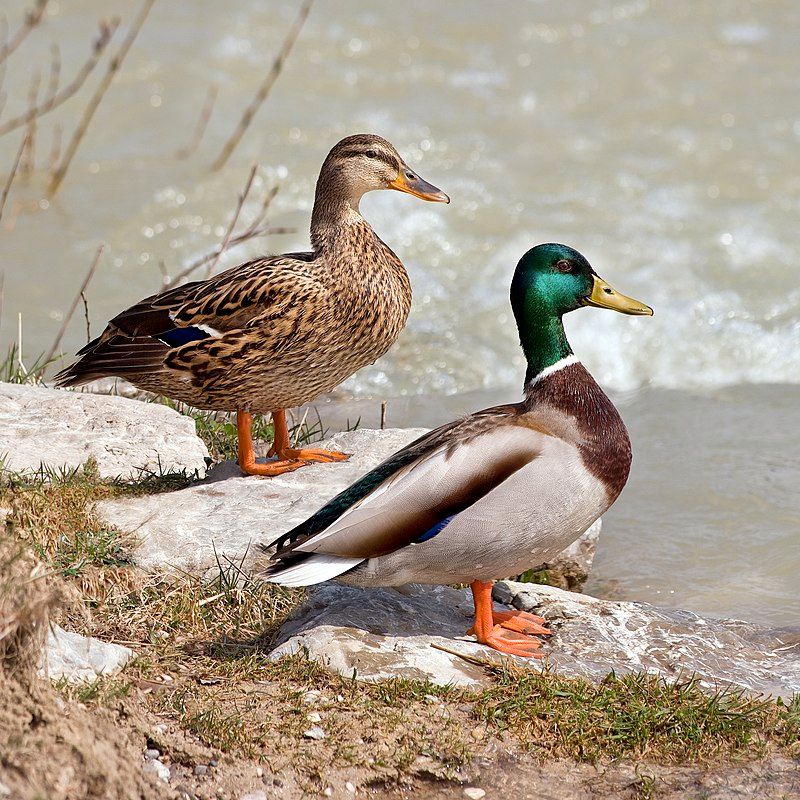
The mallard or wild duck is a widespread duck species inhabiting many parts of the world. It is a dabbling duck, meaning it feeds mainly on the surface of water or land.
It is found in various habitats in the temperate and subtropical regions of the Americas, Eurasia, and North Africa.
This species has also been introduced to other parts of the world, such as New Zealand, Australia, Peru, Brazil, Uruguay, Argentina, Chile, Colombia, the Falkland Islands, and South Africa.
This has allowed the mallard a much more comprehensive range than it would have had if it had only been found in its native habitats. The mallard is a large duck species, measuring between 20 and 26 inches long.
It is easily recognizable by its colorful plumage, predominantly brown and green, with a white belly and chest.
The male mallard has a distinctive green head and yellow bill, while the female is mainly brown with a light orange bill. The mallard is a very adaptable species, so it is found in many different regions.
It can live in areas with a wide variety of vegetation, from open fields to dense forests, and is a common sight in urban areas, such as parks and gardens.
This makes it one of the most successful and abundant duck species worldwide. The mallard has many other characteristics that make it well-suited to its environment. It is an excellent swimmer and can easily take off and land on the water.
It is also a fast flyer that can easily migrate between different regions.
Its diet consists mainly of plant matter, small fish, insects, and other aquatic invertebrates. The mallard has been a popular species for hunting and is the most commonly hunted waterfowl in North America. It is also kept as a pet and as a form of entertainment.
The species are also essential to the ecosystem, as they help to spread seeds and control insect populations.
| Kingdom | Animalia |
| Phylum | Chordata |
| Class | Aves |
| Order | Anseriformes |
| Family | Anatidae |
| Genus | Anas |
| Species | A. platyrhynchos |
3. Northern Lapwing
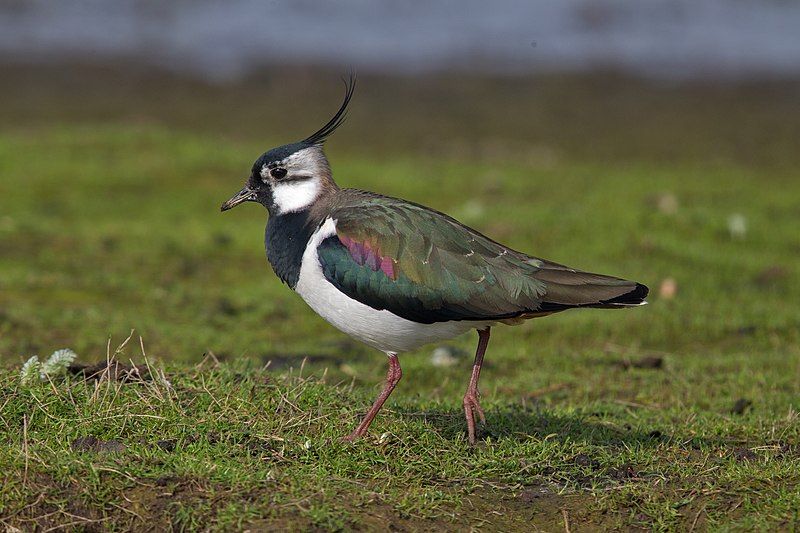
The northern lapwing is a bird that is distributed throughout temperate Eurosiberia. It is part of the lapwing subfamily and is often referred to by many names, such as peewit, tuit, twit, green plover, or eye wipe.
It is a familiar sight throughout its range in fields, meadows, and other grassy areas. Its plumage is mainly mottled brown and white, with a prominent crest on its head and a long, pointed beak.
The northern lapwing has an unmistakable call, sometimes described as the sound of a peewit, which gives the bird its alternative name. It also performs aerial displays and dives during its courtship rituals.
The northern lapwing is a versatile and adaptable species and is an essential component of many Eurasian ecosystems.
| Kingdom | Animalia |
| Phylum | Chordata |
| Class | Aves |
| Order | Charadriiformes |
| Family | Charadriidae |
| Genus | Vanellus |
| Species | V. vanellus |
4. Common Crane
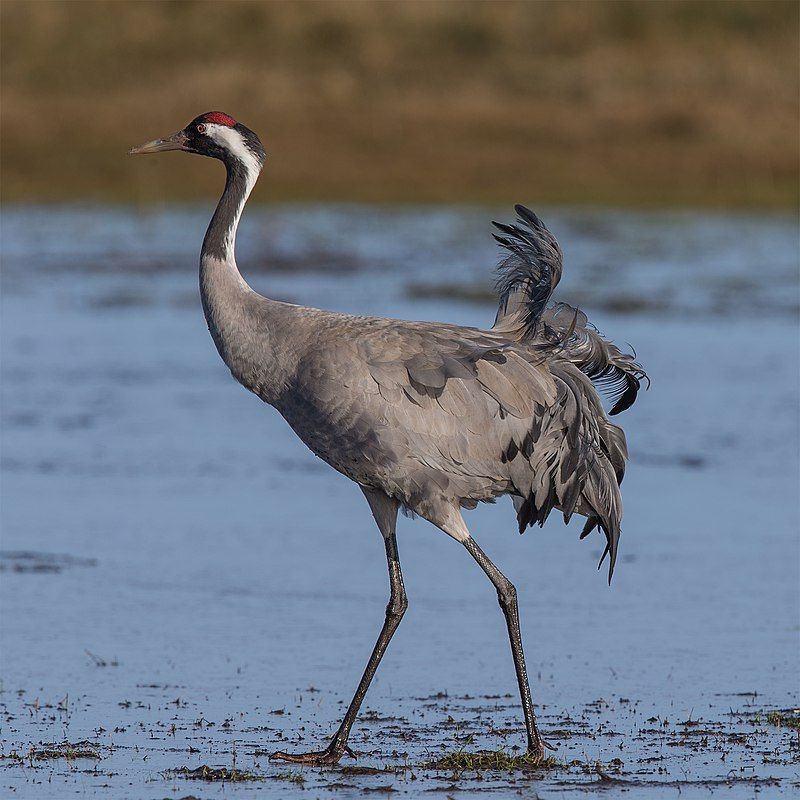
The Common Crane, also known as the Eurasian Crane, is a medium-sized bird of the Gruidae family of cranes.
It is the only crane species commonly found in Europe, with the Demoiselle Crane and the Siberian Crane being the only others regularly seen there.
The Demoiselle Crane is found mainly in the southern parts of Europe, while the Siberian Crane is only in the far eastern parts of the continent. The Common Crane is a large bird with a grey neck, chest, and white patterned back.
It has a wingspan of up to 2.1 meters and a body length of up to 1.3 meters. It prefers open wetlands, such as meadows, fields, swamps, and marshes, where it can feed on insects, worms, amphibians, and small mammals.
It also has a broad diet, including grains, berries, and other plant materials. The Common Crane is an essential species for conservation, as its population has been declining in many parts of its range due to habitat loss, hunting, and other human activities.
The population is stable or increasing in some areas, such as the Netherlands and Germany, but elsewhere, such as in Russia, the population is still declining. Conservation efforts include habitat protection, hunting regulations, and captive breeding programs.
| Kingdom | Animalia |
| Phylum | Chordata |
| Class | Aves |
| Order | Gruiformes |
| Family | Gruidae |
| Genus | Grus |
| Species | G. grus |
5. Collared Dove
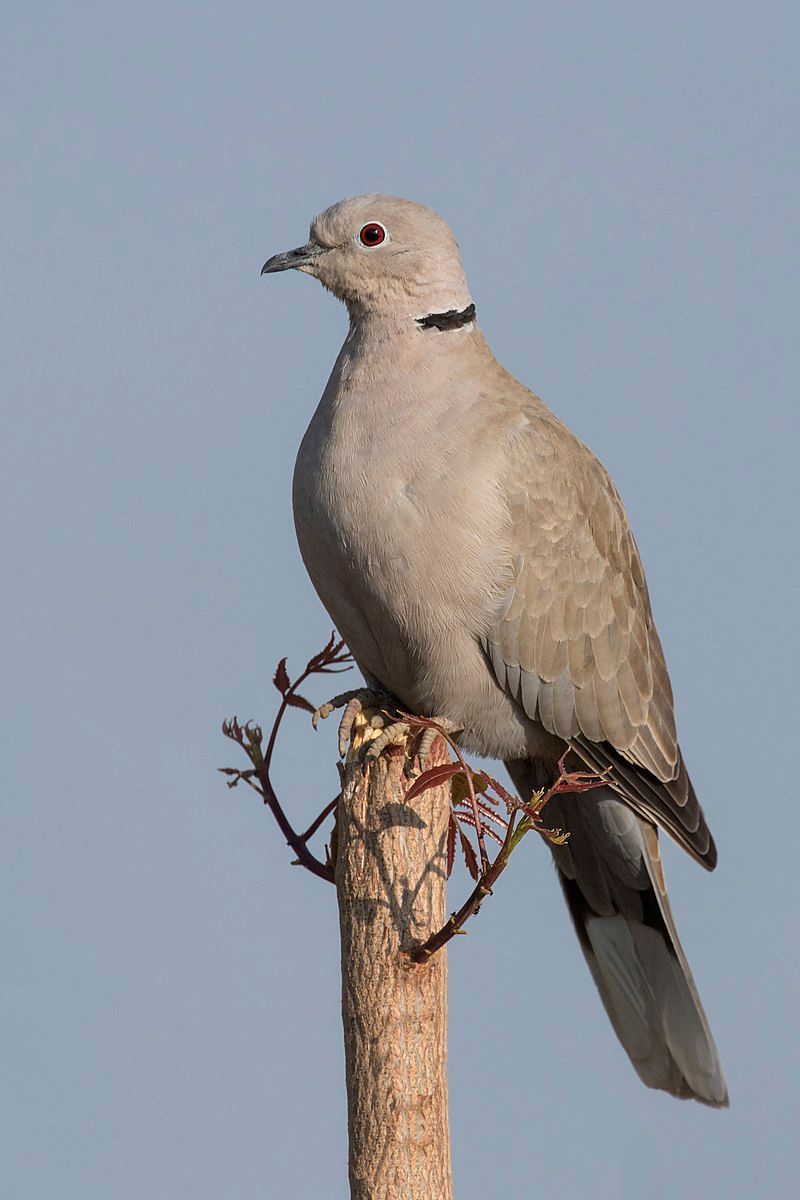
The Eurasian collared dove is a species of dove that is native to Europe and Asia. This dove species has been introduced to other countries and regions outside its native range, including Japan, North America, and islands in the Caribbean.
This dove species is known for its graceful flight and ability to adjust well to urban environments. The Eurasian collared dove has a long tail and a distinctive white collar on its neck. This species is generally a light grey color with darker grey markings.
It has a white patch on its wings, and its tail is tipped with white. The Eurasian collared dove is a medium-sized dove, typically measuring between 28 and 33 centimeters in length and weighing between 120 and 170 grams.
The Eurasian collared dove is an omnivore which eats plants and animals. Its diet comprises seeds, grains, fruits, flowers, and insects. This dove species is usually found near urban and farming areas with abundant food.
It also feeds on birdseed and other foods often found in suburban areas. The Eurasian collared dove is a social bird usually seen in pairs or small flocks. It is a strong flyer and typically migrates south during the winter months.
This dove species is generally not considered a pest, as it does not damage crops or property. The Eurasian collared dove is a species of dove that has successfully spread to many regions outside of its native range.
It is a beautiful bird species that can adapt to urban environments and is generally not considered a nuisance.
| Kingdom | Animalia |
| Phylum | Chordata |
| Class | Aves |
| Order | Columbiformes |
| Family | Columbidae |
| Genus | Streptopelia |
| Species | S. decaocto |
6. Great Spotted Woodpecker
The great spotted woodpecker is a familiar bird species found across the Palearctic region, which includes parts of North Africa. It is a medium-sized bird with black and white patches on its plumage and a distinctive red patch on the lower belly.
Males and young birds have further red markings on their necks or heads, which helps to distinguish them from females. The great spotted woodpecker is a common bird, often seen in parks and gardens.
It is an acrobatic species, and its strong beak allows it to feed on various insects. As well as feeding on insects, it eats nuts, seeds, and sap from trees. The great spotted woodpecker is a social species often seen in small groups.
It is also a vocal species with a distinctive call, which can be heard in the summer months when the birds are most active. Overall, the great spotted woodpecker is an exciting species and is an integral part of the natural environment.
With its distinctive red markings and acrobatic behavior, it is a species that will delight nature lovers of all ages.
| Kingdom | Animalia |
| Phylum | Chordata |
| Class | Aves |
| Order | Piciformes |
| Family | Picidae |
| Genus | Dendrocopos |
| Species | D. major |
7. White Stork
The white stork is one of the most giant birds in the Ciconiidae family. It has a striking appearance, with its central body feathers white and its wings black.
On average, an adult white stork will measure 100 and 115 cm from the tip of its beak to the end of its tail and have a wingspan of 155 and 215 cm. Its long red legs and pointed red beak are noticeable features that help distinguish it from other birds.
The white stork is a migratory bird, breeding in Europe, Asia, and Africa and wintering in Africa or southern Asia. It is a wading bird, often found at the edge of wetlands or in shallow waters, feeding small fish, frogs, and insects.
It has also adapted to living near humans and is often seen around farms, fields, and villages. The white stork is iconic in many cultures and symbolizes fertility and birth.
Its image is used in many religious and cultural ceremonies, and its nesting habits are seen as an omen of good luck. This bird is also an essential part of the food chain, as it helps to keep the population of insect and amphibian predators in balance.
| Kingdom | Animalia |
| Phylum | Chordata |
| Class | Aves |
| Order | Ciconiiformes |
| Family | Ciconiidae |
| Genus | Ciconia |
| Species | C. ciconia |
8. Corn Crake
The corn crake, also known as the corncrake or landrail, is a bird species belonging to the rail family. It is widely distributed across Europe and Asia, as far east as western China.
During the Northern Hemisphere’s winter, these birds migrate to Africa, where they find suitable habitats for survival. The corn crake is a medium-sized bird that measures around 30 cm in length and can weigh up to 130g.
They have a distinctive black-and-white striped crown, a streaked brown back, and a barred breast. Their bill is yellowish-pink, and their legs and feet are greenish-gray. This species is usually found in wet meadows, marshes, and damp grasslands.
They feed mainly on insects, seeds, and grains and breed between April and September. The male corn crake has a loud, booming call to attract a mate. Corncrakes are threatened by habitat loss and destruction due to agricultural practices.
It is estimated that only 10,000 and 25,000 individuals are left in the wild. To prevent further decline, conservation efforts are being made to protect their habitats and raise awareness of the importance of this species.
| Kingdom | Animalia |
| Phylum | Chordata |
| Class | Aves |
| Order | Gruiformes |
| Family | Rallidae |
| Genus | Crex |
| Species | C. crex |
9. Whooper Swan
The whooper swan, also known as the common swan, is a large bird species native to the northern hemisphere. It is easily identifiable by its white feathers, black bill, and distinctive call.
It is the largest of the swans found in Europe and Asia and one of the largest waterbirds in the world. The whooper swan is the Eurasian counterpart to the North American trumpeter swan and is the type species for the genus Cygnus.
This means that all swans in the Cygnus genus are descendants of the whooper swan.
The two species are very similar in size and shape, although the whooper swan is slightly larger. The whooper swan is an essential species economically, as it is hunted for its meat, feathers, and eggs. It is also a famous game bird and is widely kept in captivity.
The whooper swan is found in wetlands, lakes, rivers, and estuaries in the wild.
It feeds on aquatic plants, insects, crustaceans, and uproots plants to feed on roots. The whooper swan is an essential species culturally and has been featured in art, literature, and film.
It is also the national bird of Finland and a symbol of grace and beauty in many other countries.
| Kingdom | Animalia |
| Phylum | Chordata |
| Class | Aves |
| Order | Anseriformes |
| Family | Anatidae |
| Genus | Cygnus |
| Species | C. cygnus |
10. Mute Swan
The mute swan is a swan species belonging to the waterfowl family Anatidae. Its natural habitat is much of Eurasia and the northern parts of Africa. It is one of the most prominent members of the Anatidae family, with an average wingspan of up to 3 meters (10 feet).
They are white with an orange bill and black eyes. The mute swan’s most notable feature is its lack of vocalization, which is why it is known as the “mute” swan. It can produce hissing and grunting sounds but cannot vocalize like other swan species.
This species is also known for its graceful swimming and flying abilities. They can be seen gliding across the water with their long necks curved gracefully. They are also known to be very protective of their young and will defend them fiercely if threatened.
The mute swan is a beautiful bird that is an integral part of the ecosystem in its native range.
| Kingdom | Animalia |
| Phylum | Chordata |
| Class | Aves |
| Order | Anseriformes |
| Family | Anatidae |
| Genus | Cygnus |
| Species | C. olor |
11. Gadwall
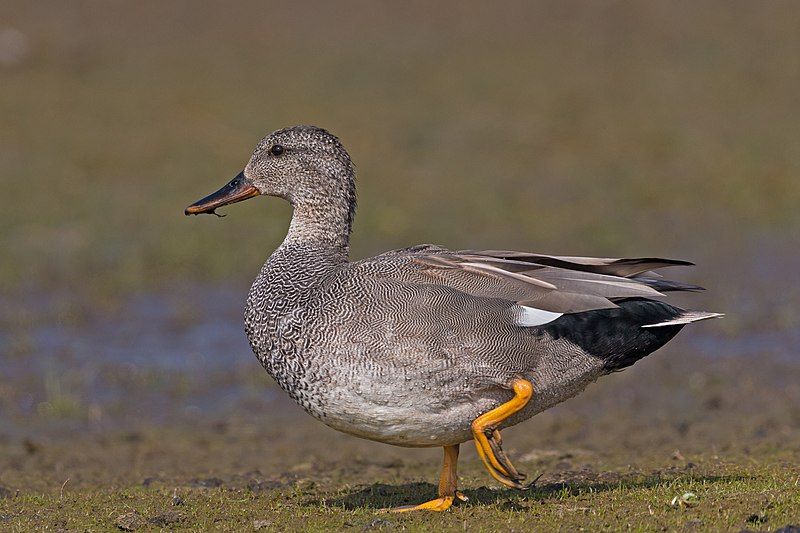
The gadwall is a species of duck belonging to the Anatidae family, one of the most prominent bird families. It is a dabbling duck, meaning it feeds mainly on the surface of bodies of water such as lakes and ponds.
The gadwall is also considered to be quite widespread, occurring in all of the continents except Antarctica. The gadwall is quite common and can be found in various habitats, including wetlands, grasslands, and urban areas.
It can be identified by its large size, long bill, and mottled brown coloration. The male gadwall has a dark head, grey body, and white patches on its wings. The female gadwall is less conspicuous, with a mottled brown coloration and a pale head.
The gadwall is a famous game bird, often seen in large flocks during migration. They are also popular with birdwatchers, as they are usually quite approachable and can be seen in various habitats.
| Kingdom | Animalia |
| Phylum | Chordata |
| Class | Aves |
| Order | Anseriformes |
| Family | Anatidae |
| Genus | Mareca |
| Species | M. strepera |
12. Eurasian Teal
The Eurasian teal is a duck species found throughout temperate Eurosiberia. It is a small dabbling duck, meaning it feeds by tipping forward in the water and scooping up food with its bill.
During the summer, the Eurasian teal breeds in temperate Eurosiberia, but when winter comes, it migrates south. It is commonly referred to as simply the teal, as it is the only species of this type of duck in much of its range.
The Eurasian teal is quite widespread, making it a popular birdwatcher species. Due to its abundance, it is also a famous game bird for hunters and is often used for food.
| Kingdom | Animalia |
| Phylum | Chordata |
| Class | Aves |
| Order | Anseriformes |
| Family | Anatidae |
| Genus | Anas |
| Species | A. crecca |
13. Great Crested Grebe
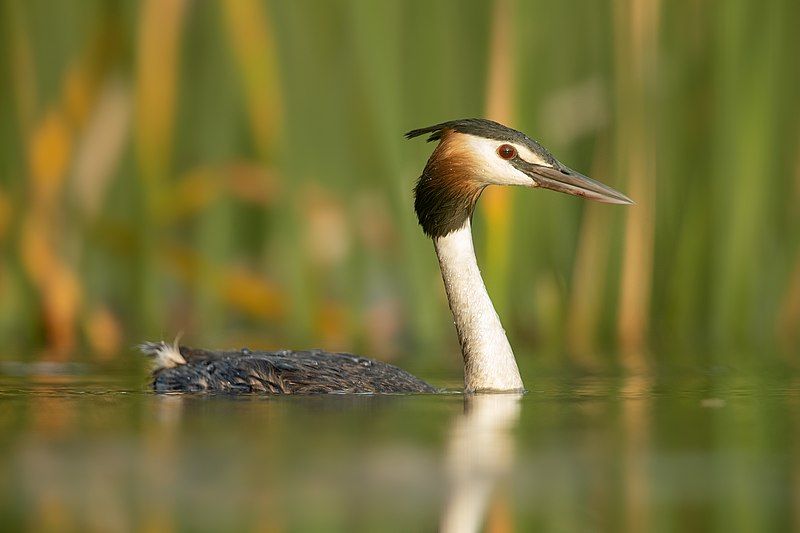
The great crested grebe (Podiceps cristatus) is a large species of water bird belonging to the Grebe family. It is found widely across Europe and Asia, occasionally in parts of Africa. It has a distinctive black and white plumage with a long, pointed bill.
The great crested grebe is mainly known for its elaborate mating display.
During the breeding season, the male and female come together in a courtship ritual that involves swimming and diving in pairs, with elaborate head and bill movements, vocalizations, and shaking of their feathers.
The courtship display is essential to pair bonding, helping the birds recognize each other and strengthen the pair bond. The great crested grebe is also a highly skilled swimmer, capable of diving to depths of up to 3 meters to find food.
It mainly feeds on fish, crustaceans, insects, and amphibians. Breeding pairs tend to remain together for life, building a floating nest of sticks and vegetation on the water’s surface. They lay up to four eggs, which the parents take turns incubating until they hatch.
The chicks can dive soon after hatching and can do so in a few weeks. The great crested grebe is a widespread species among bird watchers, and its elaborate courtship display is a sight to behold.
| Kingdom | Animalia |
| Phylum | Chordata |
| Class | Aves |
| Order | Podicipediformes |
| Family | Podicipedidae |
| Genus | Podiceps |
| Species | P. cristatus |
14. Eurasian Wigeon
The Eurasian Wigeon is a species of dabbling duck found in the Palearctic region, which spans Europe, North Africa, and parts of Asia. This species is also called the European Wigeon, or simply Wigeon.
It is one of three species belonging to the genus Mareca, including other dabbling ducks. The Eurasian Wigeon is a relatively widespread species within its range.
Its range includes many European countries, including the United Kingdom, France, Germany, and Spain. It is also found in parts of North Africa and Asia.
This species prefers to inhabit wetlands with shallow water, such as lakes, pools, and marshes, and can often be seen swimming in groups. It feeds on plant matter, small insects, and mollusks found in shallow water.
The Eurasian Wigeon is a medium-sized duck with a bright chestnut head, a pale grey-brown body, and a white stripe down its neck. It has a wingspan of around 40 to 45 cm and a body length of 40 to 50 cm.
The males are generally more significant than the females, with a distinctive white patch on their wings.
| Kingdom | Animalia |
| Phylum | Chordata |
| Class | Aves |
| Order | Anseriformes |
| Family | Anatidae |
| Genus | Mareca |
| Species | M. penelope |
15. Garganey
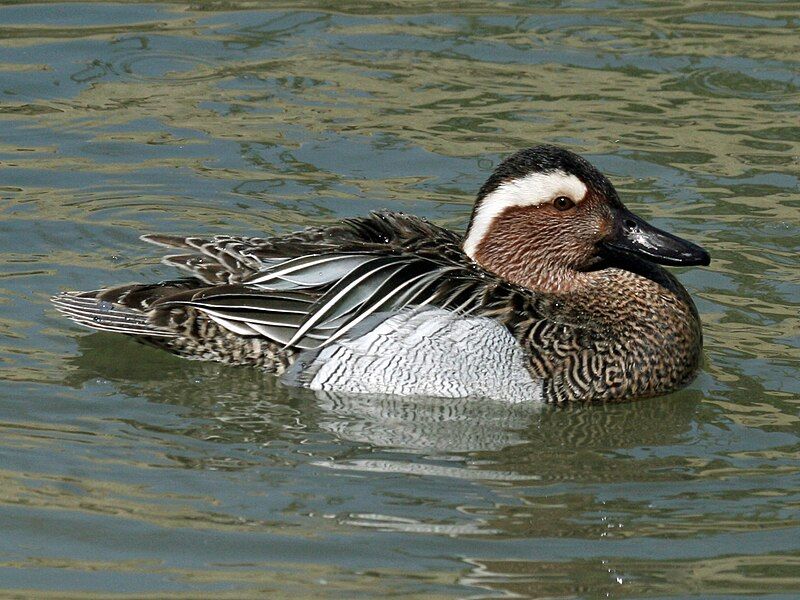
The Garganey is a small species of dabbling duck found widely across Europe and the Palearctic region.
During the winter months, the entire population of these ducks migrates to more temperate climates, with some heading south to Africa, India, Bangladesh, and Australasia. In these wintering grounds, they can be found in large flocks.
Migration is a crucial behavior of the Garganey, as it allows them to take advantage of the warmer climates during the colder months when food is more scarce in their breeding grounds. This adaptation allows them to survive and reproduce more successfully.
| Kingdom | Animalia |
| Phylum | Chordata |
| Class | Aves |
| Order | Anseriformes |
| Family | Anatidae |
| Genus | Spatula |
| Species | S. querquedula |
16. Common Pochard
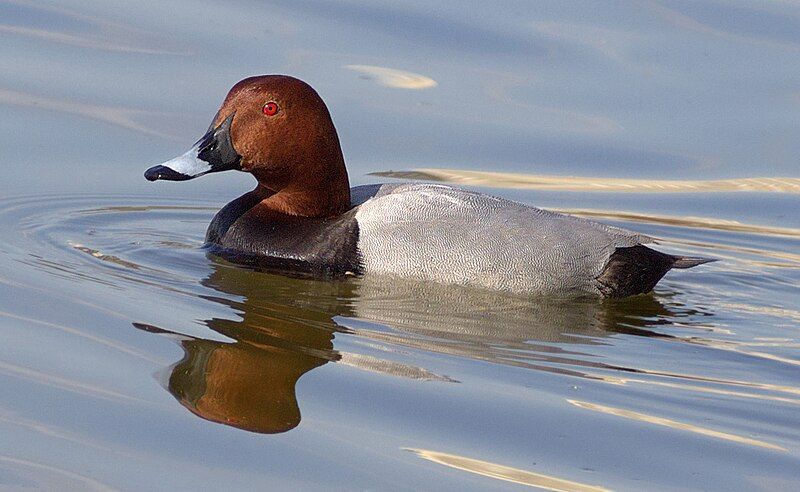
The common pochard is a species of diving duck found in many parts of the world. Its scientific name is derived from two languages: Greek and Latin. The Greek word “Lithuania” refers to an unidentified seabird mentioned by various ancient authors, such as Hesychius and Aristotle.
The Latin word “ferina” means “wild game” and is derived from the Latin word “ferus,” meaning “wild.” This scientific name provides insight into the character of the common pochard, as it suggests that this bird is wild and game-like, characteristics seen in its behavior.
| Kingdom | Animalia |
| Phylum | Chordata |
| Class | Aves |
| Order | Anseriformes |
| Family | Anatidae |
| Genus | Aythya |
| Species | A. ferina |
17. Eurasian Curlew
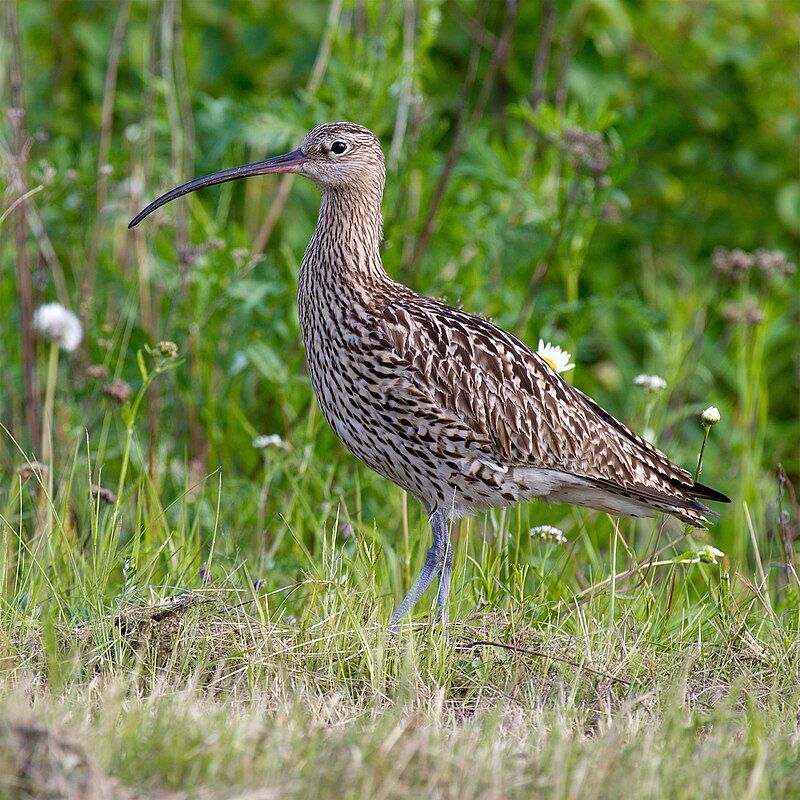
The Eurasian curlew, also known as the common curlew, is a large bird species belonging to the Scolopacidae family. It is found in many parts of temperate Europe and Asia and is a widespread species.
In Europe, the Eurasian curlew is often called the “curlew; in Scotland, it is known as the “whaup” in the Scots language. The Eurasian curlew is a distinctive bird with long legs and a curved bill.
Its plumage is mainly brown with white and black markings, and its wingspan can reach up to 1.2 meters. The Eurasian curlew prefers to inhabit coastal wetlands, riverbanks, and wet meadows, where it can find its favorite food, earthworms.
During the breeding season, it can build its nests on the ground in shallow depressions. The Eurasian curlew is a vocal bird with a loud, wailing call that can be heard over long distances.
| Kingdom | Animalia |
| Phylum | Chordata |
| Class | Aves |
| Order | Charadriiformes |
| Family | Scolopacidae |
| Genus | Numenius |
| Species | N. arquata |
18. Hazel Grouse
The hazel grouse, also known as the hazel hen, is a small bird belonging to the grouse family. It is a species that stays in one place and breeds in the Palearctic region. This region stretches from Hokkaido in the east to eastern and central Europe in the west.
The hazel grouse prefers to make its home in dense, damp, mixed coniferous forests, and it particularly likes to nest in areas with spruce trees. This grouse species can be found living in shady forest areas, such as underneath thick foliage.
It is a shy bird that usually stays hidden away in the undergrowth and is rarely seen by humans. The hazel grouse is a solitary bird that generally lives alone, although it may form small flocks during the winter months.
This species feeds primarily on the ground, eating a variety of small invertebrates, berries, nuts, and leaves. The hazel grouse is an integral part of the Palearctic ecosystem, as it helps to control insect populations and disperse the seeds of trees and other plants.
| Kingdom | Animalia |
| Phylum | Chordata |
| Class | Aves |
| Order | Galliformes |
| Family | Phasianidae |
| Genus | Tetrastes |
| Species | T. bonasia |
19. Common Cuckoo
The common cuckoo is a type of bird belonging to the Cuculiformes order, including other species such as roadrunners, anis, and coucals.
This particular species is a migratory bird, which tends to move from one location to another in different parts of the year. In the summer, it is mainly found in Europe and Asia, while it spends the winter season in Africa.
The common cuckoo is an example of a seasonal migrant, an animal that moves from one place to another due to changing climatic conditions.
This type of migratory behavior is prevalent in birds, as they often need to travel long distances to find the best sources of food and shelter. The common cuckoo is mainly known for its long-distance migration patterns.
The species also has an exciting mating behavior. The female common cuckoo lays her eggs in the nests of other birds, such as robins, dunnocks, and warblers. The host birds then incubate the eggs and raise the young cuckoos.
This strategy ensures that the young cuckoos have the best chance of survival, as they have access to the resources and protection of the host birds.
Overall, the common cuckoo is an exciting bird species with unique adaptations that allow it to survive and thrive in different habitats. Its seasonal migration and egg-laying behavior make it a fascinating species to observe and study.
| Kingdom | Animalia |
| Phylum | Chordata |
| Class | Aves |
| Order | Cuculiformes |
| Family | Cuculidae |
| Genus | Cuculus |
| Species | C. canorus |
20. Eurasian Green Woodpecker
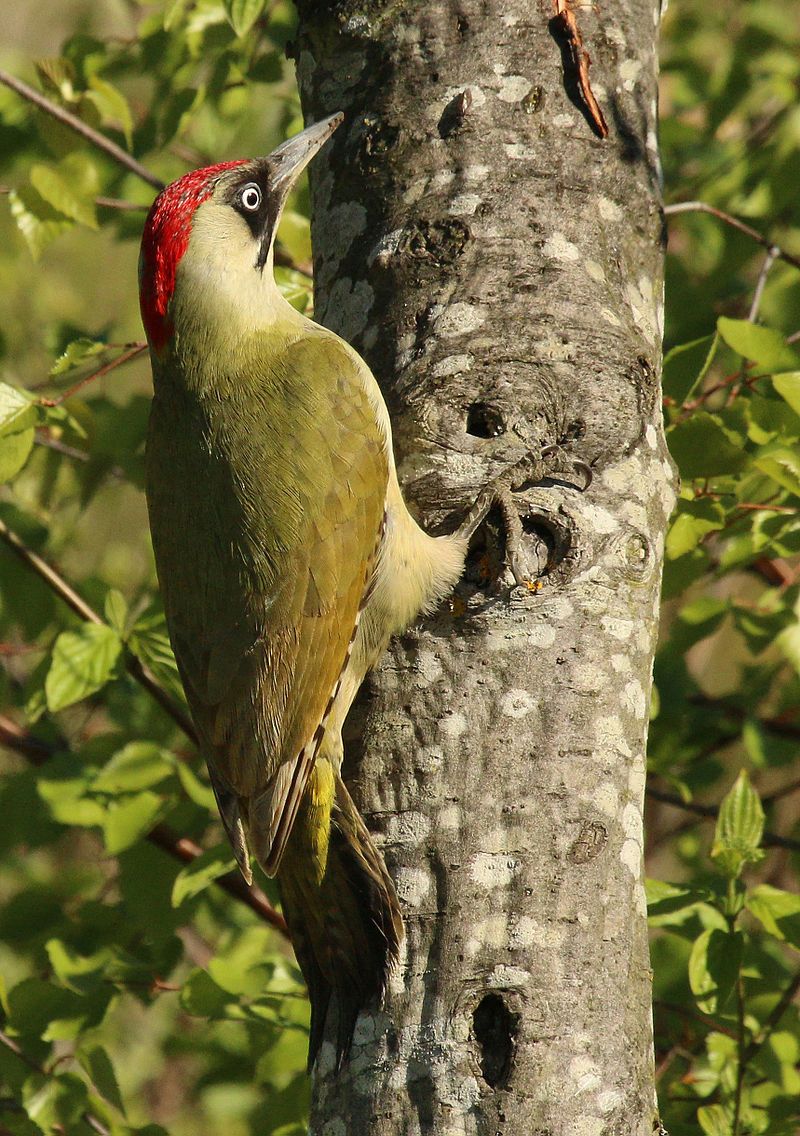
The European green woodpecker is a striking bird, easily identified by its large size and green plumage. Its bright red crown and a patch of feathers on the top of its head further distinguished it.
The male of the species also has a black mustache stripe with a red center, whereas the female lacks this feature. This is a helpful way of telling the two sexes apart and serves as an example of bird sexual dimorphism.
The European green woodpecker is found throughout Europe and parts of western Asia. It is typically found in wooded areas, including parks, gardens, and forests. Its diet consists of insects, which it obtains by hammering its bill into tree trunks and branches.
It is a reasonably common bird and is a familiar sight in many countries.
| Kingdom | Animalia |
| Phylum | Chordata |
| Class | Aves |
| Order | Piciformes |
| Family | Picidae |
| Genus | Picus |
| Species | P. viridis |
21. Great Tit
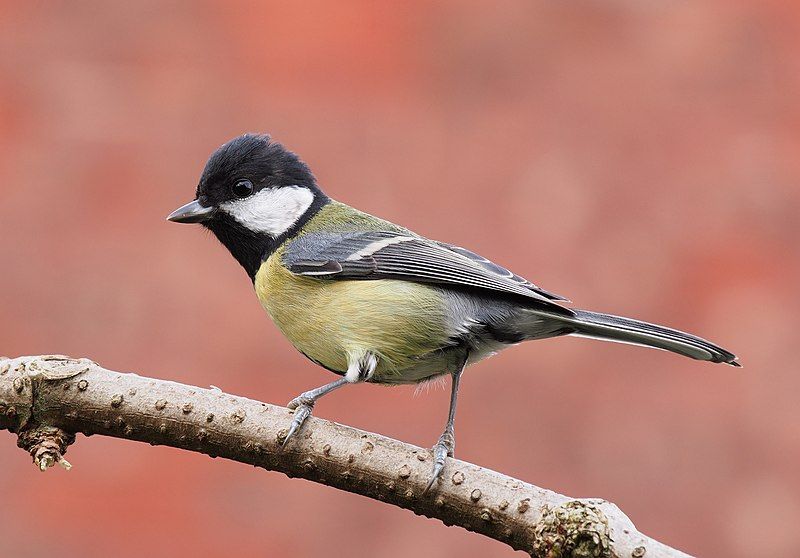
The great tit is a species of bird belonging to the Paridae family, which contains other species such as chickadees, titmice, and nuthatches. This species is native to Europe, the Middle East, Central Asia, and parts of East Asia, specifically the Amur River region.
It is a prevalent species found in various habitats, including woodlands, gardens, orchards, and parks. The great tit is a relatively large bird with a length of up to 20 cm and a wingspan of up to 30 cm.
They are a colorful species featuring a striking black and yellow head pattern. They are also very vocal birds, producing a variety of calls and songs. They feed mainly on insects and small invertebrates and take fruit and seeds when available.
Great tits can form large flocks, and they are known to be very aggressive in defending their territory. They are also very adaptable birds and have been observed to take advantage of new and novel food sources, such as peanuts placed out for them by humans.
| Kingdom | Animalia |
| Phylum | Chordata |
| Class | Aves |
| Order | Passeriformes |
| Family | Paridae |
| Genus | Parus |
| Species | P. major |
22. Tufted Duck
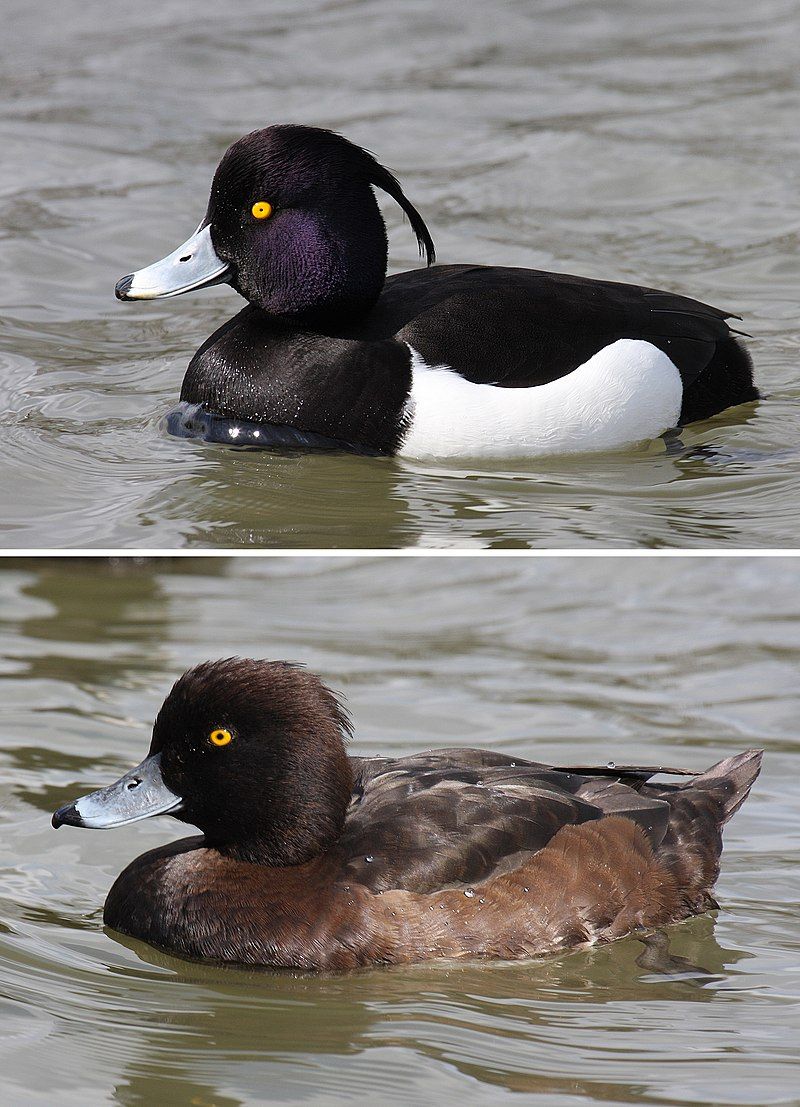
The Tufted Duck, or Tufted Pochard, is a small diving duck found in northern Eurasia. It is estimated that the population of this species is close to one million birds.
The scientific name for this species, Aythya fuligula, is derived from two Ancient Greek words: Aithuia, an unidentified seabird mentioned by authors such as Hesychius and Aristotle, and Latin words Fuligo and Gula, meaning “soot” and “throat,” respectively.
The tufted duck is a migratory species in Europe, northern Asia, and western North America. In the summer months, it can be found in the northern parts of its range, while in the winter months, it can be found in the southern parts.
The tufted duck is mainly a freshwater species but can also be found in estuaries, lakes, ponds, and rivers. The tufted duck is easily identifiable by its distinctive plumage. It has a black head, neck, and breast, with white patches on the back and sides.
It also has a white or pale yellow bill and a white eye-ring. The male has a characteristic tuft of black feathers on the head’s side, where the species gets its name.
The female is similar in appearance but lacks the tuft of feathers.
The tufted duck is a gregarious species, often seen in large flocks. It feeds mainly on aquatic vegetation, insects, and mollusks. It is also known to scavenge on carrion.
It nests in small colonies during the breeding season, usually near water.
The nest is a shallow depression lined with vegetation and down. The tufted duck is not currently classified as an endangered species. Still, its population is in decline due to various factors, such as overhunting, loss of habitat, and pollution.
To protect this species, conservation efforts are needed, such as habitat protection and creating protected areas for the species to breed.
| Kingdom | Animalia |
| Phylum | Chordata |
| Class | Aves |
| Order | Anseriformes |
| Family | Anatidae |
| Genus | Aythya |
| Species | A. fuligula |
23. Ferruginous Duck
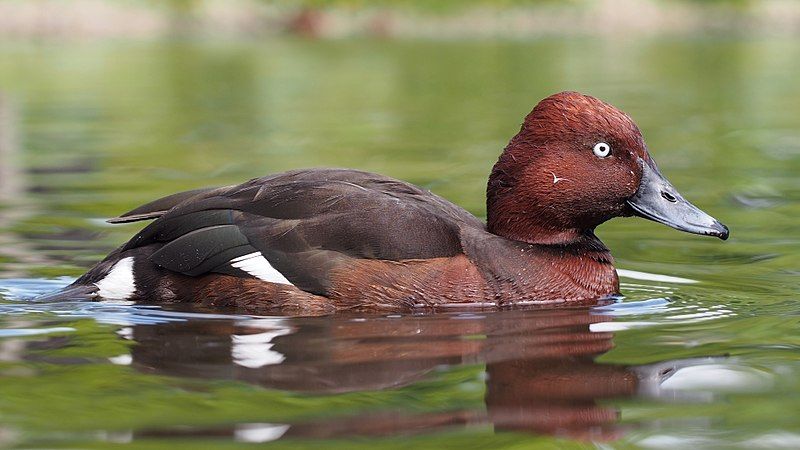
The ferruginous duck, also known as ferruginous pochard, common white-eye, or white-eyed pochard, is a medium-sized diving duck native to Eurosiberia. It is a unique species as its scientific name is derived from Greek words.
The scientific name for this duck is Aythya nyroca, derived from the Greek words “aithuia” and “nyrok”. “Lithuania” refers to an unidentified seabird that Greek authors such as Hesychius and Aristotle mentioned.
The word “nyrok” is the Russian name for a duck. This combination of words for the ferruginous duck’s scientific name clearly indicates its origin. This duck is a distinctive species, as its scientific name is derived from two different languages.
It is also an important species, the only duck species in the genus Aythya. This duck species is one of the few diving ducks in Eurosiberia; its presence is significant to the ecosystem.
| Kingdom | Animalia |
| Phylum | Chordata |
| Class | Aves |
| Order | Anseriformes |
| Family | Anatidae |
| Genus | Aythya |
| Species | A. nyroca |
24. Northern Pintail
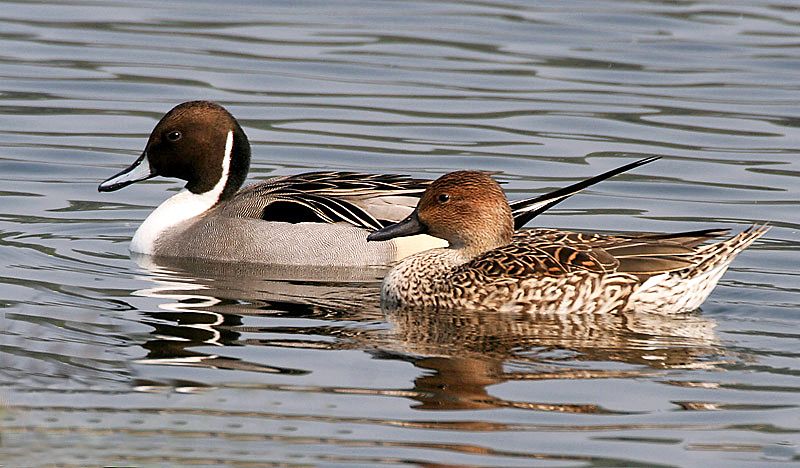
The pintail, or northern pintail, is a widely distributed duck species. It breeds in the northern regions of Europe and the Palearctic and North American regions.
It is a migratory species, and during the colder months of the year, it migrates south of its breeding range, sometimes as far as the equator.
This species is well-adapted for long-distance migrations, as it can fly for extended periods and can cover large distances in a short amount of time.
During migration, pintails can flock together in large numbers, providing protection from predators and a sense of safety in numbers. The pintail is a highly social duck species and often gathers in large flocks during the breeding season.
This species is also known for its graceful flight and its attractive plumage. It has a long, thin, pointed tail, which gives it its name.
The pintail is a beautiful duck species, and its broad geographic distribution makes it a popular species for bird watchers and other nature enthusiasts.
| Kingdom | Animalia |
| Phylum | Chordata |
| Class | Aves |
| Order | Anseriformes |
| Family | Anatidae |
| Genus | Anas |
| Species | A. acuta |
Conclusion
Birds in Greater Poland are essential to the local ecosystem, as they provide several services, such as pollination, pest control, and seed dispersal. Furthermore, birdwatching can be a great way to appreciate the beauty of the local landscape.
Bird conservation is essential for this region’s long-term well-being, so we must continue to protect and preserve the habitats of these birds.